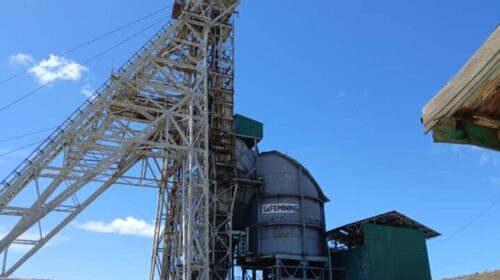Kansanshi agreement is a neat solution to a historical problem – Prof. Saasa
All shareholders in Kansanshi are now incentivised towards maximising production, says Prof. Oliver Saasa
ZCCM-IH’s recently announced decision to move from a dividend model to a revenue-sharing model has been both praised and criticised in the media but, concerningly, the rationale and details appear to be widely misunderstood. Mining For Zambia asked renowned economist Professor Oliver Saasa to shine a light on this agreement, which has been three years in the making.
There has been a significant amount of commentary in the media on the Kansanshi agreement since it was announced earlier this month. Has this surprised you?
I personally believe that the interest Zambians have shown in this deal is healthy. Citizens are interested in understanding – and even questioning – the reasoning behind decisions that have consequences for the larger economy. So, it is essential that the public is properly informed about the intricacies and technical details of this agreement, to ensure that people’s opinions are founded on facts – and not on fiction. What the commentators are asking is pertinent: ‘Whose idea was this transaction? How did it come about?’ For those that have followed its genesis, it’s clear that both ZCCM-IH and First Quantum [FQM] have wanted a change, and feel that the dividend model is no longer fit for purpose for either party.
What do you understand to be the rationale behind ZCCM-IH’s desire to convert its dividend rights in Kansanshi into royalty rights? Or, put differently, what’s in this deal for ZCCM-IH, as you see it?
As ZCCM-IH has explained publicly, a review of its portfolio’s performance in 2019 revealed that the dividend model had not been maximising shareholder value because it was not delivering predictable revenues. For this reason, pursuing alternative revenue streams became a focus in its subsequent Strategic Plan, for 2020-2026. Securing consistent revenue flows from its investment portfolio (via royalties) is a solution that addresses the unpredictability of dividend payments, which were not serving ZCCM-IH’s interests.
The Minister of Finance stated last week that the reason for coming to this new agreement was – in short – for ZCCM-IH to get more money. Do you agree that cash generation should be the priority for ZCCM-IH?
I certainly do. For Government, the more significant inflow into the Treasury it receives from its investments, the better. So, yes, the Minister is right.
It’s important to remember that ZCCM-IH isn’t a standard investor with a standard investment strategy. It’s a state-owned enterprise with its own particular set of goals, and that’s essentially why it’s now considering a different model. Ordinarily, standard mining investors are looking for capital appreciation (a rising share price) as well as dividends. Why? Because this gives them the option to sell once their shares have significantly risen from the initial purchase price. The prospect of capital appreciation is what incentivises them to support the reinvestment of a company’s annual profits, to improve the future prospects of the business; they aren’t solely driven by maximising annual dividends.
For ZCCM-IH, a sale of shares is simply not an option, so their return on investments is limited to the annual dividends they receive. This explains why there has been misalignment between FQM and ZCCM-IH on the Board of Kansanshi: the former was incentivised to re-invest profits, whereas the other needed maximum payout of profits, through annual dividends.
Do you see any obvious disadvantages to ZCCM-IH or the Zambian people from this agreement?
No, I don’t. As I see it, it’s quite clear that ZCCM-IH will be able to extract more value from Kansanshi than would have been the case through dividends. Let us look at the historical payment trends that have been shared: A comparison of actual dividends received from Kansanshi between 2009 and 2021 versus a 3.1% royalty shows that the average dividend income per annum was US$24m, compared to average royalty income per annum that would have amounted to US$48m. In short, the overall average revenue from the royalty model that ZCCM-IH has opted for is expected not only to be higher, but also more predictable and consistent. If you ask me, this could be a model for all mining business in Zambia to consider.
“As I see it, it’s quite clear that ZCCM-IH will be able to extract more value from Kansanshi than would have been the case through dividends.”
Does this deal appear to be in line with the Government’s desire to extract more value from the mining sector, and/or to dramatically increase production?
Indeed, the synergy is clear. This agreement can be viewed as a very neat solution to the misalignment of FQM and ZCCM-IH’s interests which, ultimately, have been inhibiting production at Kansanshi. As I said before, there had previously been an inherent conflict of interest between ZCCM-IH and FQM and its investors, over the use of annual returns for reinvestment. Because ZCCM-IH will now directly benefit from reinvestment and expansion of operations – as any increase in production will be reflected in a commensurate increase in the royalty payment – this will no longer be a source of disagreement. Similarly, if the copper price rises, then so will revenues earned (as the price of each unit of copper sold increases) so ZCCM-IH will benefit here too.
The bad blood and resulting disputes between FQM and ZCCM-IH over the years (which has stemmed from this conflict in approach) have been very damaging for both parties, reputationally and operationally – and also for the country more generally as an investment destination – so it really is positive that both FQM and ZCCM-IH have fashioned such a neat solution to this historical problem.
In this sense, the agreement is very much part of the wider ‘reset’ between FQM and the Government, first announced in May this year with these massive investments into the Kansanshi expansion, and the new Enterprise nickel mine. If we are to kickstart our mining industry back to life, it is essential that the interests of the parties involved are aligned towards driving production. For that reason, this agreement genuinely is a win-win for both parties, and I think this has been overlooked in much of the analysis so far.
“If we are to kickstart our mining industry back to life, it is essential that the interests of the parties involved are aligned towards driving production.”
This transaction has been widely misunderstood as the sale of ZCCM-IH’s 20% stake in Kansanshi. What would you say to Zambians who are concerned about ZCCM-IH losing control over this important asset?
I would say: Rest assured, the ZCCM-IH stake in Kansanshi remains intact and secured. The transaction agreement – which is in the public domain, by the way – states that ZCCM-IH will continue to hold all of its current shares, meaning that it continues to be a 20% shareholder in Kansanshi. ZCCM-IH also continues to have 2 Directors (out of 10) on the Kansanshi Board, with voting rights.
In terms of governance, the company has full visibility of Kansanshi’s operations, including the right to attend the mine site and to inspect Kansanshi’s books and records to ensure it is satisfied with royalty calculations. It’s also worth bearing in mind that, should First Quantum ever want to sell its stake in Kansanshi – even though ZCCM-IH has a minority shareholding – it continues to hold its pre-emptive rights, meaning that it has priority over other potential buyers of First Quantum’s shares.
It is my expectation that the full details of the financial impact of the restructuring on ZCCM-IH will be made public by ZCCM-IH itself prior to its AGM, when shareholders are expected to approve the agreement. Perhaps it may be helpful for the Government and ZCCM-IH to clarify these details for the general public before then.

Some commentators have suggested that a royalty of 3.1% is too low. How would an agreement over this rate have been reached?
I understand that independent financial and legal advisors, both international and local, were contracted by ZCCM-IH to carry out the valuation, and to assist in the negotiations. What is particularly noteworthy is that the 3.1% royalty is expected to yield almost twice the payments to ZCCM-IH under the dividends model. In this regard, one needs to justify the argument that 3.1% is too low in the light of this reality. The 3.1% is also on the high end of the average global range, which should bring sufficient comfort to the public.
Will the royalty payable to ZCCM-IH replace or reduce mineral royalty taxes (MRT) payable to the State?
No, the ZCCM-IH royalty in no way replaces mineral royalty taxes. The new arrangement will have no effect on the overall amount of tax payable to the State.
You may have seen recent media commentary comparing the Kansanshi agreement with the current negotiations between FQM and the Panamanian Government. Is this a fair comparison to make? Please explain.
It is completely incorrect for anyone to be comparing the discussions with the Panamanian Government to the Kansanshi agreement. The Panama discussions (which are ongoing, by the way) are between FQM and the Government, regarding the taxes to be applied and paid to Panama’s Government. In other words, it’s equivalent to discussing the amounts that Zambia’s Government collects from FQM. The Kansanshi agreement, on the other hand, is an agreement with a minority shareholder, namely ZCCM-IH, to change the way they receive a return on their investment. These commentators are simply not comparing apples with apples.
There has been some recent commentary suggesting that the ZCCM-IH royalty will be income tax deductible – as mineral royalties are – and that the State will therefore be losing out on profits tax from this new arrangement. Can you clarify the position here?
I expect that the royalties payments will be income tax deductible for Kansanshi as these are a cost to the business. In other words, tax will not be paid on revenue (or, sales) which are not retained by the company, but on profits, which is in line with general tax principles and best practice. However, as income to ZCCM-IH, I expect these sums to be subject to tax by the Revenue Authority (ZRA). In this regard, the dividend-royalty agreement will be tax neutral from the ZRA standpoint.
How important is this reset for the reinvigoration of Zambia’s mining industry, and how important is the ending of bitter legal disputes for Zambia’s image with other potential investors?
This dividends-royalty transaction is very much part of the wider discussions between the New Administration and FQM on how best to work together to move Zambia forward as a key mining jurisdiction, and to secure the ambitious copper production targets set by the Government. The Minister of Finance made this quite clear during a recent press briefing on the agreement.
In the spirit of these discussions, it was agreed by both ZCCM-IH and Kansanshi that all current and historic legal disputes would be withdrawn or settled. I am not privy to the technical details regarding these legal issues. But suffice to say that the decision to pursue legal routes must always be weighed against the cost of delayed actions. One need only look at the KCM and Mopani issues to see the net negative effects that protracted legal battles have had for Zambia, in terms of holding back the development of the sector.
To find out the details of ZCCM-IH’s agreement with Kansanshi, read our exclusive interview with ZCCM-IH’s Board Chair, Ms Dolika Banda, here.
99 total views , 1 views today






[…] ZCCM-IH’s recently announced decision to move from a dividend model to a revenue-sharing model has been both praised and criticised in the media but, concerningly, the rationale and details appear to be widely misunderstood. Mining For Zambia asked renowned economist Professor Oliver Saasa to shine a light on this agreement, which has been three years in the making. There has been a significant… Read full details […]